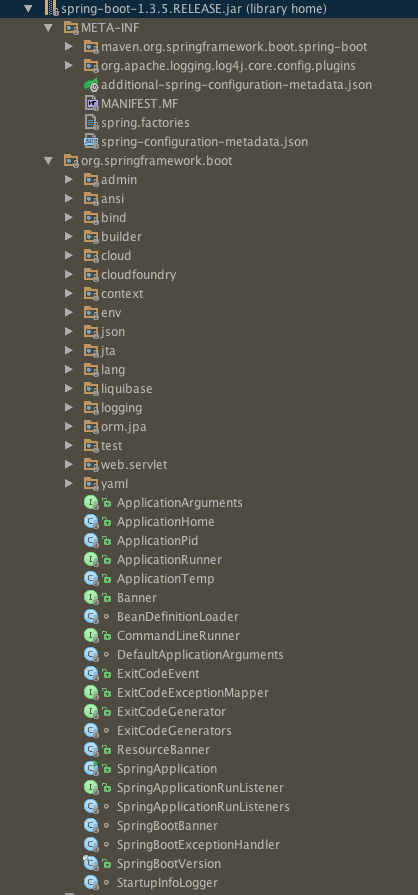springboot用来简化Spring框架带来的大量XML配置以及复杂的依赖管理,让开发人员可以更加关注业务逻辑的开发。
比如不使用springboot而使用SpringMVC作为web框架进行开发的时候,需要配置相关的SpringMVC配置以及对应的依赖,比较繁琐;而使用springboot的话只需要以下短短的几行代码就可以使用SpringMVC,可谓相当地方便:
@RestController
class App {
@RequestMapping("/")
String home() {
"hello"
}
}
其中maven配置如下:
<parent>
<groupId>org.springframework.boot</groupId>
<artifactId>spring-boot-starter-parent</artifactId>
<version>1.3.5.RELEASE</version>
</parent>
<dependencies>
<dependency>
<groupId>org.springframework.boot</groupId>
<artifactId>spring-boot-starter-web</artifactId>
</dependency>
</dependencies>
我们以使用SpringMVC并且视图使用freemarker为例,分析springboot内部是如何解析freemarker视图的。
如果要在springboot中使用freemarker视图框架,并且使用maven构建项目的时候,还需要加入以下依赖:
<dependency>
<groupId>org.springframework.boot</groupId>
<artifactId>spring-boot-starter-freemarker</artifactId>
<version>1.3.5.RELEASE</version>
</dependency>
这个spring-boot-starter-freemarker依赖对应的jar包里的文件如下:
META-INF
├── MANIFEST.MF
├── maven
│ └── org.springframework.boot
│ └── spring-boot-starter-freemarker
│ ├── pom.properties
│ └── pom.xml
└── spring.provides
内部的pom.xml里需要的依赖如下:
<dependency>
<groupId>org.springframework.boot</groupId>
<artifactId>spring-boot-starter</artifactId>
</dependency>
<dependency>
<groupId>org.springframework.boot</groupId>
<artifactId>spring-boot-starter-web</artifactId>
</dependency>
<dependency>
<groupId>org.freemarker</groupId>
<artifactId>freemarker</artifactId>
</dependency>
<dependency>
<groupId>org.springframework</groupId>
<artifactId>spring-context-support</artifactId>
</dependency>
我们可以看到这个spring-boot-starter-freemarker依赖内部并没有freemarker的ViewResolver,而是仅仅加入了freemarker的依赖,还有3个依赖,分别是spring-boot-starter、spring-boot-starter-web和spring-context-support。
接下来我们来分析一下为什么在springboot中加入了freemarker的依赖spring-boot-starter-freemarker后,SpringMVC自动地构造了一个freemarker的ViewResolver?
在分析之前,首先我们先看下maven配置,看到了一个parent配置:
<parent>
<groupId>org.springframework.boot</groupId>
<artifactId>spring-boot-starter-parent</artifactId>
<version>1.3.5.RELEASE</version>
</parent>
这个spring-boot-starter-parent的pom文件在 http://central.maven.org/maven2/org/springframework/boot/spring-boot-starter-parent/1.3.5.RELEASE/spring-boot-starter-parent-1.3.5.RELEASE.pom 里。
它内部也有一个parent:
<parent>
<groupId>org.springframework.boot</groupId>
<artifactId>spring-boot-dependencies</artifactId>
<version>1.3.5.RELEASE</version>
<relativePath>../../spring-boot-dependencies</relativePath>
</parent>
这个spring-boot-dependencies的pom文件在http://central.maven.org/maven2/org/springframework/boot/spring-boot-dependencies/1.3.5.RELEASE/spring-boot-dependencies-1.3.5.RELEASE.pom,内部有很多依赖。
比如spring-boot-starter-web、spring-boot-starter-websocket、spring-boot-starter-data-solrspring-boot-starter-freemarker等等,基本上所有的依赖都在这个parent里。
我们的例子中使用了parent依赖里的两个依赖,分别是spring-boot-starter-web和spring-boot-starter-freemarker。
其中spring-boot-starter-web内部依赖了spring的两个spring web依赖:spring-web和spring-webmvc。
spring-boot-starter-web内部还依赖spring-boot-starter,这个spring-boot-starter依赖了spring核心依赖spring-core;还依赖了spring-boot和spring-boot-autoconfigure这两个。
spring-boot定义了很多基础功能类,像运行程序的SpringApplication,Logging系统,一些tomcat或者jetty这些EmbeddedServlet容器,配置属性loader等等。
包括了这些包:

spring-boot-autoconfigure定义了很多自动配置的类,比如jpa,solr,redis,elasticsearch、mongo、freemarker、velocity,thymeleaf等等自动配置的类。
以freemarker为例,看一下它的自动化配置类:
@Configuration // 使用Configuration注解,自动构造一些内部定义的bean
@ConditionalOnClass({ freemarker.template.Configuration.class,
FreeMarkerConfigurationFactory.class }) // 需要freemarker.template.Configuration和FreeMarkerConfigurationFactory这两个类存在在classpath中才会进行自动配置
@AutoConfigureAfter(WebMvcAutoConfiguration.class) // 本次自动配置需要依赖WebMvcAutoConfiguration这个配置类配置之后触发。这个WebMvcAutoConfiguration内部会配置很多Wen基础性的东西,比如RequestMappingHandlerMapping、RequestMappingHandlerAdapter等
@EnableConfigurationProperties(FreeMarkerProperties.class) // 使用FreeMarkerProperties类中的配置
public class FreeMarkerAutoConfiguration {
private static final Log logger = LogFactory
.getLog(FreeMarkerAutoConfiguration.class);
@Autowired
private ApplicationContext applicationContext;
@Autowired
private FreeMarkerProperties properties;
@PostConstruct // 构造之后调用的方法,组要检查模板位置是否存在
public void checkTemplateLocationExists() {
if (this.properties.isCheckTemplateLocation()) {
TemplateLocation templatePathLocation = null;
List<TemplateLocation> locations = new ArrayList<TemplateLocation>();
for (String templateLoaderPath : this.properties.getTemplateLoaderPath()) {
TemplateLocation location = new TemplateLocation(templateLoaderPath);
locations.add(location);
if (location.exists(this.applicationContext)) {
templatePathLocation = location;
break;
}
}
if (templatePathLocation == null) {
logger.warn("Cannot find template location(s): " + locations
+ " (please add some templates, "
+ "check your FreeMarker configuration, or set "
+ "spring.freemarker.checkTemplateLocation=false)");
}
}
}
protected static class FreeMarkerConfiguration {
@Autowired
protected FreeMarkerProperties properties;
protected void applyProperties(FreeMarkerConfigurationFactory factory) {
factory.setTemplateLoaderPaths(this.properties.getTemplateLoaderPath());
factory.setPreferFileSystemAccess(this.properties.isPreferFileSystemAccess());
factory.setDefaultEncoding(this.properties.getCharsetName());
Properties settings = new Properties();
settings.putAll(this.properties.getSettings());
factory.setFreemarkerSettings(settings);
}
}
@Configuration
@ConditionalOnNotWebApplication // 非Web项目的自动配置
public static class FreeMarkerNonWebConfiguration extends FreeMarkerConfiguration {
@Bean
@ConditionalOnMissingBean
public FreeMarkerConfigurationFactoryBean freeMarkerConfiguration() {
FreeMarkerConfigurationFactoryBean freeMarkerFactoryBean = new FreeMarkerConfigurationFactoryBean();
applyProperties(freeMarkerFactoryBean);
return freeMarkerFactoryBean;
}
}
@Configuration // 自动配置的类
@ConditionalOnClass(Servlet.class) // 需要运行在Servlet容器下
@ConditionalOnWebApplication // 需要在Web项目下
public static class FreeMarkerWebConfiguration extends FreeMarkerConfiguration {
@Bean
@ConditionalOnMissingBean(FreeMarkerConfig.class)
public FreeMarkerConfigurer freeMarkerConfigurer() {
FreeMarkerConfigurer configurer = new FreeMarkerConfigurer();
applyProperties(configurer);
return configurer;
}
@Bean
public freemarker.template.Configuration freeMarkerConfiguration(
FreeMarkerConfig configurer) {
return configurer.getConfiguration();
}
@Bean
@ConditionalOnMissingBean(name = "freeMarkerViewResolver") // 没有配置freeMarkerViewResolver这个bean的话,会自动构造一个freeMarkerViewResolver
@ConditionalOnProperty(name = "spring.freemarker.enabled", matchIfMissing = true) // 配置文件中开关开启的话,才会构造
public FreeMarkerViewResolver freeMarkerViewResolver() {
// 构造了freemarker的ViewSolver,这就是一开始我们分析的为什么没有设置ViewResolver,但是最后却还是存在的原因
FreeMarkerViewResolver resolver = new FreeMarkerViewResolver();
this.properties.applyToViewResolver(resolver);
return resolver;
}
}
}
freemarker对应的配置类:
@ConfigurationProperties(prefix = "spring.freemarker") // 使用配置文件中以spring.freemarker开头的配置
public class FreeMarkerProperties extends AbstractTemplateViewResolverProperties {
public static final String DEFAULT_TEMPLATE_LOADER_PATH = "classpath:/templates/"; // 默认路径
public static final String DEFAULT_PREFIX = ""; // 默认前缀
public static final String DEFAULT_SUFFIX = ".ftl"; // 默认后缀
...
}
下面是官网上的freemarker配置:
# FREEMARKER (FreeMarkerAutoConfiguration)
spring.freemarker.allow-request-override=false # Set whether HttpServletRequest attributes are allowed to override (hide) controller generated model attributes of the same name.
spring.freemarker.allow-session-override=false # Set whether HttpSession attributes are allowed to override (hide) controller generated model attributes of the same name.
spring.freemarker.cache=false # Enable template caching.
spring.freemarker.charset=UTF-8 # Template encoding.
spring.freemarker.check-template-location=true # Check that the templates location exists.
spring.freemarker.content-type=text/html # Content-Type value.
spring.freemarker.enabled=true # Enable MVC view resolution for this technology.
spring.freemarker.expose-request-attributes=false # Set whether all request attributes should be added to the model prior to merging with the template.
spring.freemarker.expose-session-attributes=false # Set whether all HttpSession attributes should be added to the model prior to merging with the template.
spring.freemarker.expose-spring-macro-helpers=true # Set whether to expose a RequestContext for use by Spring's macro library, under the name "springMacroRequestContext".
spring.freemarker.prefer-file-system-access=true # Prefer file system access for template loading. File system access enables hot detection of template changes.
spring.freemarker.prefix= # Prefix that gets prepended to view names when building a URL.
spring.freemarker.request-context-attribute= # Name of the RequestContext attribute for all views.
spring.freemarker.settings.*= # Well-known FreeMarker keys which will be passed to FreeMarker's Configuration.
spring.freemarker.suffix= # Suffix that gets appended to view names when building a URL.
spring.freemarker.template-loader-path=classpath:/templates/ # Comma-separated list of template paths.
spring.freemarker.view-names= # White list of view names that can be resolved.
所以说一开始我们加入了一个spring-boot-starter-freemarker依赖,这个依赖中存在freemarker的lib,满足了FreeMarkerAutoConfiguration中的ConditionalOnClass里写的freemarker.template.Configuration.class这个类存在于classpath中。
所以就构造了FreeMarkerAutoConfiguration里的ViewResolver,这个ViewResolver被自动加入到SpringMVC中。
同样地,如果我们要使用velocity模板,springboot内部也有velocity的自动配置类VelocityAutoConfiguration,原理是跟freemarker一样的。
其他:
Mybatis的autoconfigure是Mybatis提供的springboot的自动配置模块,由于springboot官方没有提供mybatis的自动化配置模块,所以mybatis自己写了这么一个模块,观察它的源码,发现基本上跟freemarker的autoconfigure模块一样,只需要构造对应的实例即可。
总结:
springboot内部提供了很多自动化配置的类,这些类会判断classpath中是否存在自己需要的那个类,如果存在则会自动配置相关的配置,否则就不会自动配置。
如果我们需要使用一些框架,只需要加入依赖即可,这些依赖内部是没有代码的,只是一些对应框架需要的lib,有了这些lib就会触发自动化配置,于是就能使用框架了。
这一点跟当时看springmvc的时候对response进行json或xml渲染的原理相同。springmvc中的requestmapping注解加上responsebody注解后会返回xml或者json,如果依赖中加入jackson依赖就会转换成json,如果依赖中加入xstream依赖就会转换成xml。当然,前提是springmvc中有了这两种依赖的HttpMessageConverter代码,这个HttpMessageConverter代码就相当于springboot中的各种AutoConfiguration。
